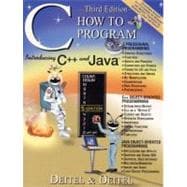This is the long-awaited, thorough revision to the world's best-selling introductory C book! Harvey and Paul Deitel have thoroughly updated the book to reflect the latest techniques and ANSI C enhancements, to add detailed introductions to C++, Java, and object-oriented programming, and more. The book's powerful "teach by example" approach is based on more than 10,000 lines of live code, thoroughly explained and illustrated with screen captures showing detailed output. World-renowned corporate trainers and best-selling authors Harvey and Paul Deitel offer the most comprehensive, practical introduction to C ever published -- with hundreds of hands-on exercises, more than 250 complete programs written and documented for easy learning, and exceptional insight into good programming practices, maximizing performance, avoiding errors, debugging, and testing. New features include thorough introductions to C++, Java, and object-oriented programming that build directly on the C skills taught in this book; coverage of graphical user interface development and C library functions; and many new, substantial hands-on projects. For anyone who wants to learn C, improve their existing C skills, and understand how C serves as the foundation for C++, Java, and object-oriented development.









